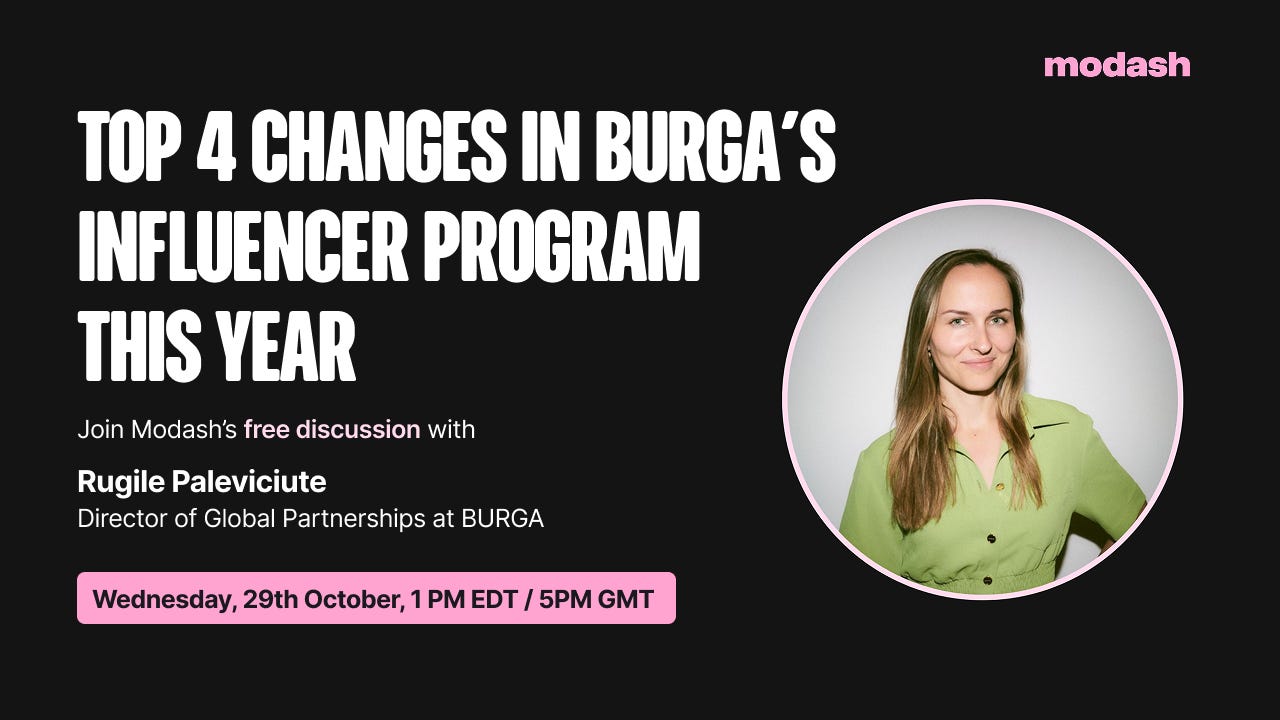The Quiet Algorithmic Spiral
🧠When your rankings fluctuate week to week, the actual problem is….
Hey Readers 🥰
Welcome to today’s edition, bringing the latest growth stories fresh to your inbox.
And just a quick heads-up! If you stumbled upon us through a friend, make sure to subscribe below! That way, you’ll never miss out on the trending stories.
Partnership with Modash
The discount code era is over.
Here’s the truth: everything you know about influencer marketing might be wrong. The brands truly succeeding know how to stop relying on endless discount codes.
Modash has your back - not just with an incredible influencer marketing tool, but with a free webinar that will change how you think about influencer marketing.
Join Rugile Paleviciute, Director of Global Partnerships at BURGA, as she shares the top 4 changes her 26-person in-house team made to their influencer program this year.
Learn to:
Measure real influence
Reduce discount dependency
Strengthen creator loyalty
Reach audiences that actually convert.
Register for free, and if you’re unable to attend, no worries, you’ll receive the replay!
🧠 The Quiet Algorithmic Spiral
When your rankings fluctuate week to week, you don’t have a traffic problem, you have a signal synchronization problem.
Modern SEO systems don’t penalize mistakes outright; they compound them quietly. You fix a title, rewrite a page, merge content, and suddenly your domain authority “breathes” like a volatile stock.
What’s happening isn’t a penalty, it’s signal misalignment, the invisible force behind the modern rank decay spiral.
⚙️ How SEO Systems Drift
Google and AI-driven engines don’t crawl, they learn.
Every change you make retrains their internal understanding of your brand. When those signals arrive too fast or too inconsistently, the system loses confidence in what you stand for.
That loss shows up as:
Keyword Cannibalization: Topical edges blur as similar pages compete for relevance.
Entity Confusion: AI models stop linking your brand to consistent intent patterns.
Equity Fragmentation: Internal links pass weight unevenly after restructures or merges.
These aren’t random dips. They’re feedback loops triggered by uncoordinated optimization cycles.
🔍 The New Stabilization Model
To stop drift, you have to slow the system down. Not by editing less, but by sequencing better. The new model is called Signal Phasing, a method where technical, topical, and semantic changes are rolled out in deliberate waves:
Wave 1 – Structural Stabilization: Fix internal linking and canonical consistency before touching copy.
Wave 2 – Topical Recalibration: Refresh clusters one at a time, letting Google relearn entity alignment.
Wave 3 – Context Integration: Once stability returns, optimize for prompt visibility and AI answer inclusion.
The pacing isn’t arbitrary, it mirrors how AI retrains. Your brand narrative must remain steady long enough for the model to absorb it.
🧩 Tracking the Invisible Layer
Pattern drift can’t be seen in traditional analytics. You need to track it at the signal level:
Topical density changes → where meaning dilutes.
AI summary movement → how large-language models reinterpret your expertise.
SERP volatility cycles → the timing gaps between recovery and relapse.
That’s where the SEMrush AI SEO Toolkit earns its place; it shows exactly how your brand’s content and AI mentions shift together across Google, ChatGPT, and Gemini.
You can start here to visualize where updates stabilize or destabilize your authority before another rollout.
🚀 The 2025 Operator Rulebook
Stop treating SEO like a series of quick fixes. You’re not optimizing pages, you’re tuning a live system with memory and inertia.
The brands that dominate next year won’t be the ones who push updates the fastest; they’ll be the ones who let their systems settle long enough to compound authority.
Control your signals, control your stability. Because in 2025, SEO won’t reward activity, it will reward discipline.
🚀Quick Hits
😲 AWS and Azure keep billing for the time you didn’t even use. Nebius ends that. You get free migration, three months free, and GPU pricing at $2/hr flat. That’s 50% faster model training, 30% lower spend, and zero surprise invoices. Lock in your free months before the next billing cycle.
🔗 X is testing a new in-app browser that keeps users on-platform when opening links, letting them like or reply while reading.
📉 Google Ads will now permanently delete canceled accounts after six months, erasing all campaign data, reports, and assets. Advertisers get a 30-day warning before deletion, ending indefinite account reactivation.
🍪 Google officially shuts down Privacy Sandbox, ending its years-long bid to replace third-party cookies. The closure restores ad stability but leaves privacy-first advertising without a clear, scalable future path.
🔍 Only 45% of U.S. shoppers now start product research on Google, while AI tools (15%) and review sites (14%) surge ahead. 73% use AI search more than last year, and 52% turn to social media for reviews.
Advertise with Us
70% of email clicks are bots but not with The Playbook. Reach real human buyers with verified clicks and only pay for actual engagement.
We'd love to hear your feedback on today's issue! Simply reply to this email and share your thoughts on how we can improve our content and format. 😍


Hey, great read as alaways. Totally agree, that quiet algorithmic spiral is so real.